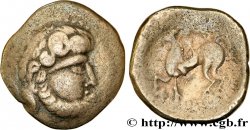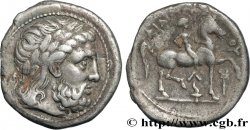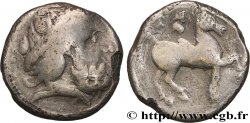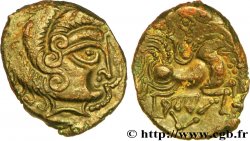bga_177705 - DANUBIAN CELTS - IMITATIONS OF THE TETRADRACHMS OF PHILIP II AND HIS SUCCESSORS Tétradrachme “au monogramme d’Audoléon”
Not available.
Item sold on our e-shop
Price : 750.00 €
Item sold on our e-shop
Price : 750.00 €
Type : Tétradrachme “au monogramme d’Audoléon”
Date: c. IIe-Ier siècles AC.
Metal : silver
Diameter : 23,7 mm
Orientation dies : 8 h.
Weight : 13,2 g.
Rarity : R2
Coments on the condition:
Très beau portrait sur un flan relativement large. Revers stylisé. Frappe un tout petit peu faible sur la partie supérieure du cavalier au revers. Jolie patine de médaillier, avec une légère rayure à 12h au revers et sur la queue du cheval
Obverse
Obverse legend : ANÉPIGRAPHE.
Obverse description : Tête barbare, laurée et barbue de Zeus à droite.
Reverse
Reverse legend : ANÉPIGRAPHE.
Reverse description : Cavalier très stylisé, sur un cheval plus réaliste ; une volute devant le poitrail, une esse bouletée sous la jambe gauche du cheval et un fleuron sous le ventre.
Commentary
Sur ce type, la couronne de laurier est très importante d'où l'appellation de "Verkehrten Lorbeerkranz". Elle est de plus perlée aux extrémités, visible sur notre exemplaire au-dessus du front. Au revers, outre le monogramme, nous avons deux symboles énigmatiques, l'esse bouletée entre les antérieurs du cheval et la volute devant le poitrail.








 Report a mistake
Report a mistake Print the page
Print the page Share my selection
Share my selection Ask a question
Ask a question Consign / sell
Consign / sell
 Full data
Full data










